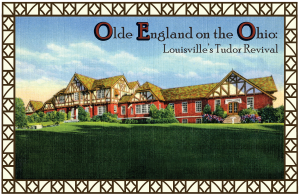Join the Filson Historical Society for the opening of the latest exhibit, Olde England on the Ohio. Louisville’s Tudor Revival. Participants will have the opportunity to meet the curators in the gallery to engage in conversation and answer questions. This a free event open to the public but registration is required.
Louisville’s residents and visitors often note the city’s proliferation of Tudor Revival architecture. From homes to businesses, churches to charities, Louisville has retained an impressive Tudor Revival collection, including several neighborhoods where it is the dominant style.
Olde England on the Ohio: Louisville’s Tudor Revival uses Louisville as a microcosm of a larger national movement that peaked in the 1920s and early 1930s. Tudor Revival not only manifested through architecture, but also in consumer products and popular culture. The exhibit shows the range of ways Americans looked to recreate a near-mythic “Merrie Olde England” in the early twentieth century.
Importantly, it was no accident that this turn towards an imaginary English past coincided with a wave of Eastern European immigrants, a massive African-American migration to northern cities, and the refinement of continued systems of racial, religious, and ethnic injustice. Many explicitly saw Tudor Revival as a way of claiming and elevating Anglo-Saxon heritage for a select few.
But in Louisville these attempts ultimately failed. Olde England on the Ohio demonstrates how diverse groups across the city used Tudor Revival to make their own assertations about belonging and participation in American culture. The objects, images, and artifacts we have gathered ultimately suggest that Tudor Revival succeeded as a movement built from the ground up, not the top down. We hope you will visit us to explore this eye-opening and entertaining exhibit.
This exhibit is guest curated by Dr. Daniel Gifford, a public historian who focuses on American popular and visual culture, as well as museums in American culture. He received his Ph.D. from George Mason University in 2011 and serves on the Filson Historical Society’s Board of Directors.

